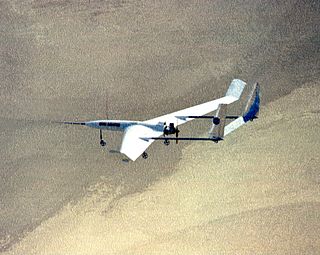
Jet Propulsion Laboratory (JPL) is a federally funded research and development center in Pasadena, California, United States. Founded in 1936 by Caltech researchers, the laboratory is now owned and sponsored by the National Aeronautics and Space Administration (NASA) and administered and managed by the California Institute of Technology.

An aerobot is an aerial robot, usually used in the context of an unmanned space probe or unmanned aerial vehicle.
This timeline of artificial satellites and space probes includes uncrewed spacecraft including technology demonstrators, observatories, lunar probes, and interplanetary probes. First satellites from each country are included. Not included are most Earth science satellites, commercial satellites or crewed missions.

A Mars sample-return (MSR) mission is a proposed mission to collect rock and dust samples on Mars and return them to Earth. Such a mission would allow more extensive analysis than that allowed by onboard sensors.

Timeline for the Mars Reconnaissance Orbiter (MRO) lists the significant events of the launch, aerobraking, and transition phases as well as subsequent significant operational mission events; by date and brief description.

Jezero is a crater on Mars in the Syrtis Major quadrangle, about 45.0 km (28.0 mi) in diameter. Thought to have once been flooded with water, the crater contains a fan-delta deposit rich in clays. The lake in the crater was present when valley networks were forming on Mars. Besides having a delta, the crater shows point bars and inverted channels. From a study of the delta and channels, it was concluded that the lake inside the crater probably formed during a period in which there was continual surface runoff.

A Mars aircraft is a vehicle capable of sustaining powered flight in the atmosphere of Mars. So far, the Mars helicopter Ingenuity was the only aircraft ever to fly on Mars, completing 72 successful flights covering 17.242 km (10.714 mi) in 2 hours, 8 minutes and 55 seconds of flight time.Ingenuity had been operating on Mars for 1042 sols before retirement, when one or more of its rotor blades was damaged, causing NASA to retire the craft.

Mars 2020 is a NASA mission that includes the rover Perseverance, the now-retired small robotic helicopter Ingenuity, and associated delivery systems, as part of the Mars Exploration Program. Mars 2020 was launched on an Atlas V rocket at 11:50:01 UTC on 30 July 2020, and landed in the Martian crater Jezero on 18 February 2021 with confirmation received at 20:55 UTC. On 5 March 2021, NASA named the landing site Octavia E. Butler Landing. As of 31 January 2024, Perseverance has been on Mars for 1048 sols. Ingenuity operated on Mars for 1042 sols before sustaining serious damage, causing NASA to retire the craft on 25 January 2024.

Lunar Flashlight was a low-cost CubeSat lunar orbiter mission to explore, locate, and estimate size and composition of water ice deposits on the Moon for future exploitation by robots or humans.

Ingenuity, nicknamed Ginny, is an autonomous NASA helicopter that operated on Mars from 2021 to 2024 as part of the Mars 2020 mission. The helicopter arrived on the planet attached to the underside of the Perseverance rover, which landed February 18, 2021. Ingenuity made its first flight on April 19, 2021, the first powered, controlled extraterrestrial flight by any aircraft. Originally intended to make five flights, the rotorcraft greatly exceeded expectations and made a total of 72 flights over a period of about 3 years until rotor damage sustained in January 2024 forced an end to the mission.

Farah Alibay is a Canadian systems engineer at the NASA Jet Propulsion Laboratory who has worked on the InSight, Mars Cube One, and Mars 2020 missions.

MiMi Aung is a Burmese-American engineer. Currently, she is director of technical program management for Amazon's Project Kuiper, an initiative to increase broadband internet access through an array of satellites in low Earth orbit.

Perseverance, nicknamed Percy, is a car-sized Mars rover designed to explore the Jezero crater on Mars as part of NASA's Mars 2020 mission. It was manufactured by the Jet Propulsion Laboratory and launched on July 30, 2020, at 11:50 UTC. Confirmation that the rover successfully landed on Mars was received on February 18, 2021, at 20:55 UTC. As of 30 January 2024, Perseverance has been active on Mars for 1047 sols since its landing. Following the rover's arrival, NASA named the landing site Octavia E. Butler Landing.

The Mars 2020 mission, along with its rover Perseverance and helicopter Ingenuity, was launched from Earth on July 30, 2020. On February 15, 2022, The New York Times provided an overview of the Mars 2020 mission events since the landing in Jezero crater on Mars in February 2021. As of January 27, 2024, Perseverance has been on the planet Mars for 1044 sols. Ingenuity had been operating on Mars for 1042 sols before retirement, when one or more of its rotor blades was damaged, causing NASA to retire the craft.

Håvard Fjær Grip is a Norwegian cybernetics engineer and robotics technologist. He was the chief pilot of NASA's Jet Propulsion Laboratory's Mars helicopter, Ingenuity, and led the development of its aerodynamics and flight control system. Grip successfully flew Ingenuity's first flight on Mars on April 19, 2021, which made history as the first extraterrestrial helicopter flight. As of October 2023, he is chief engineer of the Mars Sample Recovery Helicopters, part of the NASA-ESA Mars Sample Return campaign.

J. "Bob" Balaram is an Indian-American scientist and engineer currently working for National Aeronautics and Space Administration. He is the chief engineer and designer of Ingenuity, the first extraterrestrial aircraft, that was attached underside of car-sized Perseverance rover that successfully landed on the Mars in February 2021.
Loay Elbasyouni is a Palestinian–American electrical engineer. He helped design the Mars rover Perseverance and was an electrical and power electronics lead in the team that built the Ingenuity helicopter.

The Mars Sample Recovery Helicopters are a pair of robotic unmanned helicopters being developed by the engineers of the American company AeroVironment Inc. and proposed in March 2022 as a means of delivering Martian soil samples from the sample depots made by the Perseverance rover to the location of the Sample Retrieval Lander (SRL) that will load these samples onto the Mars Ascent Vehicle (MAV), which, in accordance with the NASA-ESA Mars Sample Return program, will deliver them to low Martian orbit for future return to Earth.

Jennifer Harris Trosper is an American aerospace engineer at the Jet Propulsion Laboratory (JPL) in Pasadena, California. During her 30-year career at JPL, Trosper has occupied crucial positions in engineering management pertaining to every spacecraft that has traversed the Martian surface. Because of her leadership and engineering expertise, Trosper has appeared on broadcast media outlets as an authority in development and execution of missions to Mars.
















